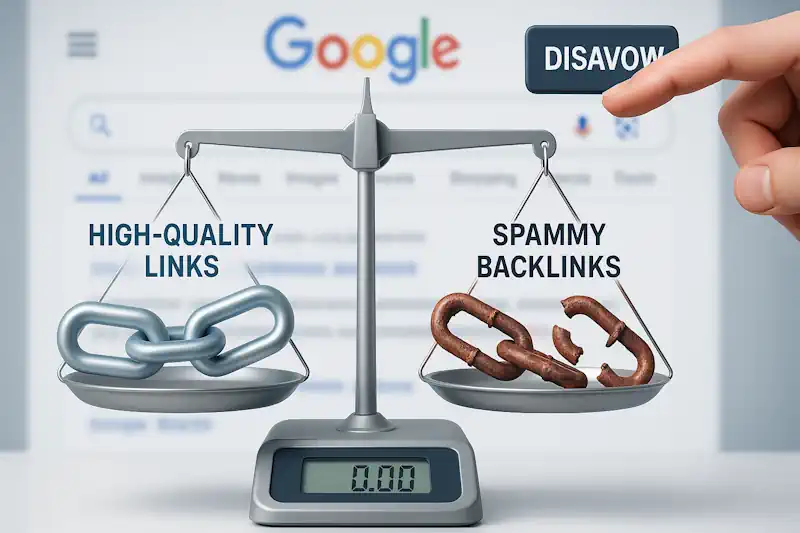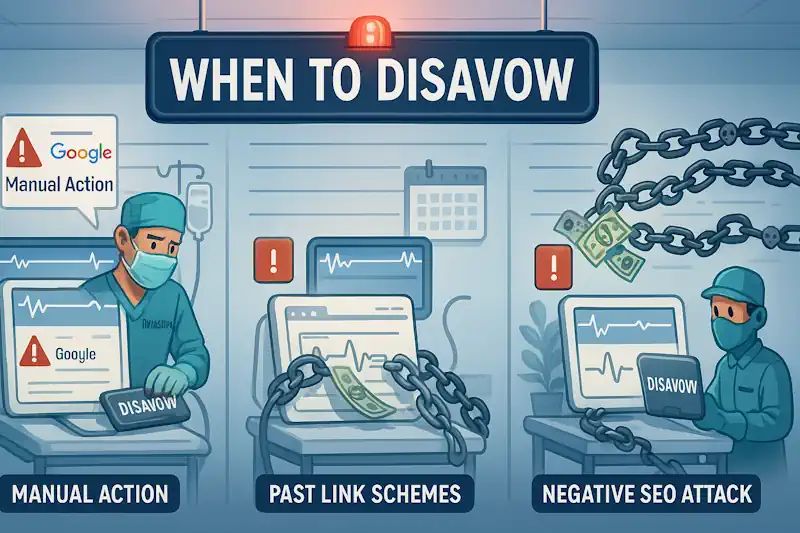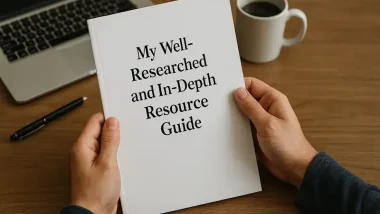So you’ve been hearing about “bad backlinks” and this whole disavowal thing, right? Some SEO gurus tell you to clean house immediately, while others warn that touching your backlink profile might raise red flags with Google. Talk about confusing!

Let’s talk about this backlink dilemma and figure out what’s actually best for your website.
The Backlink Basics (A Quick Refresher)
First things first – backlinks are simply links from other websites pointing to yours. They’re like digital votes of confidence, telling Google, “Hey, this site is worth checking out!” For years, they’ve been a crucial ranking factor.
But not all backlinks are created equal. Some come from reputable, relevant sources and can boost your rankings. Others come from spammy, low-quality sites and might potentially harm your SEO efforts.
The Evolution of Google’s Thinking
Remember the old days when people would buy thousands of spammy links and shoot up the rankings? Google sure does, and they weren’t happy about it!
In 2012, Google released the Penguin algorithm update specifically targeting manipulative link schemes. Suddenly, having lots of sketchy backlinks could actually hurt your rankings. That’s when the disavow tool entered the scene – a way for webmasters to tell Google, “I don’t want to be associated with these links!”
But here’s the interesting part: Google’s systems have gotten much smarter since then.
Today’s Reality: Google’s Sophisticated Approach
These days, Google’s algorithms are pretty darn good at identifying low-quality links all by themselves. In fact, John Mueller (a Google Search Advocate) has stated multiple times that Google generally just ignores spammy links rather than penalizing sites for them.
It’s kind of like how you automatically filter out junk mail – you don’t punish the people sending the spam; you just ignore the irrelevant stuff.
So Should You Disavow Bad Backlinks?
The answer isn’t black and white, but here’s a practical approach:
When to Consider Disavowing:
- You’ve received a manual action notification in Google Search Console specifically mentioning unnatural links. This is Google actually telling you there’s a problem that needs addressing.
- You know you’ve engaged in link schemes in the past. If you or a previous SEO company purchased links or participated in link exchanges that violate Google’s guidelines, cleaning those up shows good faith.
- You’re seeing clear evidence of negative SEO attacks where competitors might be building toxic links to your site deliberately. (This is relatively rare, but I have seen it happen!)

When to Probably Leave Things Alone:
- Random, low-quality links that appear naturally. Almost every website accumulates some junky backlinks over time. Google expects this and is good at filtering them out.
- Links you didn’t create and have no control over. If you didn’t ask for them and they’re just part of the natural web ecosystem, Google likely understands this.
- No signs of penalty or ranking drops. If your site is performing well, there’s wisdom in the “if it ain’t broke, don’t fix it” approach.
How to Identify “Bad” Backlinks
Wondering what exactly makes a backlink “bad”? Let’s break down the red flags that might indicate a potentially harmful backlink:
Common Characteristics of Low-Quality Backlinks:
- Extremely low domain authority – While a low DA (Domain Authority) score like 1-10 isn’t automatically bad, it’s often a warning sign when combined with other factors. Remember that even new legitimate sites start with low DA.
- Irrelevant to your niche – Links from sites that have nothing to do with your industry or topic (a plumbing site linking to a fashion blog with no context) often signal low quality.
- Spammy-looking domains – URLs with excessive numbers, strange character combinations, or keyword stuffing (e.g., best-seo-backlinks-cheap-services-2025.info) are typically red flags.
- Thin or auto-generated content – Sites with little original content, scraper sites, or pages that seem machine-generated without providing value.
- Excessive outbound links – Pages that link out to dozens or hundreds of unrelated websites are often link farms created specifically for manipulation.
- Foreign language sites (if unrelated to your target market) – While multilingual links can be legitimate, a sudden influx of links from foreign language sites you’ve never engaged with could be suspicious.
- Sites with malware or security warnings – If browsers flag the linking site as dangerous, that’s a clear signal it’s not a quality backlink.
- Adult, gambling, or other prohibited content (if unrelated to your niche) – Links from these industries can be problematic if they’re not relevant to your business.
- Links from comment sections, forums, or profile pages – Especially when they appear in large numbers and contain exact-match anchor text.
- Private Blog Networks (PBNs) – Sites that exist primarily to pass link equity, often sharing similar design templates, hosting, or registration details.
- Sudden unnatural spikes – Getting hundreds of new backlinks in a short period, especially with identical anchor text, is usually suspicious.

Context Matters More Than Metrics
It’s important to note that individual metrics like Domain Authority, Page Authority, or Trust Flow shouldn’t be used in isolation to judge backlink quality. A more holistic approach includes:
- Relevance – Does the linking site make sense as a reference to your content?
- Editorial intent – Was the link placed manually by a human editor who found value in your content?
- User experience – Is the linking page something real users would find helpful?
- Placement context – Is your link placed naturally within content or stuffed in footers/sidebars with hundreds of other links?
Tools to Help Identify Problematic Links
Several tools can help you assess your backlink profile:
- Google Search Console (free and essential)
- Ahrefs, SEMrush, or Moz (paid options with more detailed metrics)
- Majestic SEO (particularly useful for Trust Flow/Citation Flow analysis)
Remember that even the best tools require human judgment. A link that looks “bad” on paper might actually be perfectly legitimate in context, and vice versa. This is why mass disavowals based solely on automated metrics are generally not recommended.
Will Google Think You’re Gaming the System?
Here’s where some confusion comes in. Some SEOs worry that using the disavow tool signals to Google that you’ve been trying to manipulate rankings.
But think about it this way: If you’re selectively disavowing clearly problematic links (especially ones you know violated guidelines), you’re actually showing Google you’re trying to play by the rules. It’s like coming clean rather than trying to hide something.
What Google might find suspicious is if you’re constantly disavowing perfectly normal links or using the tool excessively without clear reason. That could suggest you’re trying to manipulate your backlink profile.
A Practical Approach for Peace of Mind
If you’re still concerned about your backlink profile, here’s a balanced approach:
- Monitor your backlinks using Google Search Console or third-party tools like Ahrefs, SEMrush, or Moz.
- Look for patterns, not individual links. A few random links from questionable sites aren’t worth worrying about, but hundreds of links from similar low-quality sources might warrant attention.
- Check for manual actions in Google Search Console regularly. This is Google’s direct communication channel with you about serious issues.
- Be selective with disavowals. If you do decide to disavow, focus only on clearly manipulative or harmful links, not everything that looks slightly off.
The Bottom Line
The disavow tool is like a fire extinguisher – it’s important to have when you really need it, but you shouldn’t go spraying it around for no good reason!
For most websites, Google’s algorithms are sophisticated enough to figure out which links to count and which to ignore. The occasional spammy backlink is just part of life on the web, not something to lose sleep over.

Focus your energy on creating great content and earning genuine backlinks rather than obsessing over every questionable link pointing to your site. That’s not just better for your SEO in the long run – it’s definitely better for your stress levels, too!
Remember, Google’s ultimate goal is to reward sites that provide value to users, not to punish well-intentioned site owners over backlinks they didn’t even create. So take a deep breath – your backlink profile probably isn’t as scary as some SEO tools might make it seem.
What’s your experience with backlinks? Have you used the disavow tool before? I’d love to hear your thoughts!
